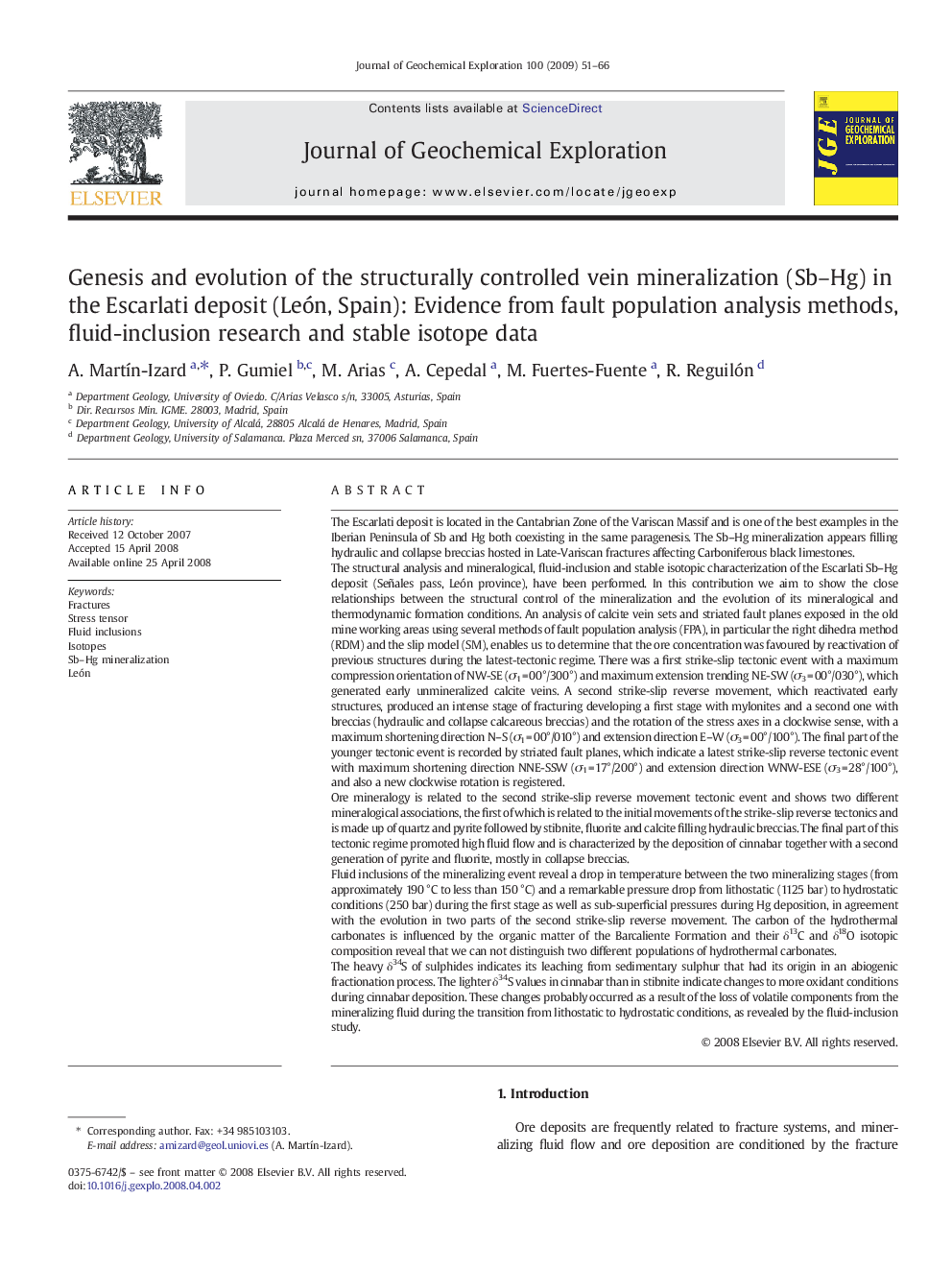| کد مقاله | کد نشریه | سال انتشار | مقاله انگلیسی | نسخه تمام متن |
|---|---|---|---|---|
| 4458237 | 1312660 | 2009 | 16 صفحه PDF | دانلود رایگان |

The Escarlati deposit is located in the Cantabrian Zone of the Variscan Massif and is one of the best examples in the Iberian Peninsula of Sb and Hg both coexisting in the same paragenesis. The Sb–Hg mineralization appears filling hydraulic and collapse breccias hosted in Late-Variscan fractures affecting Carboniferous black limestones.The structural analysis and mineralogical, fluid-inclusion and stable isotopic characterization of the Escarlati Sb–Hg deposit (Señales pass, León province), have been performed. In this contribution we aim to show the close relationships between the structural control of the mineralization and the evolution of its mineralogical and thermodynamic formation conditions. An analysis of calcite vein sets and striated fault planes exposed in the old mine working areas using several methods of fault population analysis (FPA), in particular the right dihedra method (RDM) and the slip model (SM), enables us to determine that the ore concentration was favoured by reactivation of previous structures during the latest-tectonic regime. There was a first strike-slip tectonic event with a maximum compression orientation of NW-SE (σ1 = 00°/300°) and maximum extension trending NE-SW (σ3 = 00°/030°), which generated early unmineralized calcite veins. A second strike-slip reverse movement, which reactivated early structures, produced an intense stage of fracturing developing a first stage with mylonites and a second one with breccias (hydraulic and collapse calcareous breccias) and the rotation of the stress axes in a clockwise sense, with a maximum shortening direction N–S (σ1 = 00°/010°) and extension direction E–W (σ3 = 00°/100°). The final part of the younger tectonic event is recorded by striated fault planes, which indicate a latest strike-slip reverse tectonic event with maximum shortening direction NNE-SSW (σ1 = 17°/200°) and extension direction WNW-ESE (σ3 = 28°/100°), and also a new clockwise rotation is registered.Ore mineralogy is related to the second strike-slip reverse movement tectonic event and shows two different mineralogical associations, the first of which is related to the initial movements of the strike-slip reverse tectonics and is made up of quartz and pyrite followed by stibnite, fluorite and calcite filling hydraulic breccias. The final part of this tectonic regime promoted high fluid flow and is characterized by the deposition of cinnabar together with a second generation of pyrite and fluorite, mostly in collapse breccias.Fluid inclusions of the mineralizing event reveal a drop in temperature between the two mineralizing stages (from approximately 190 °C to less than 150 °C) and a remarkable pressure drop from lithostatic (1125 bar) to hydrostatic conditions (250 bar) during the first stage as well as sub-superficial pressures during Hg deposition, in agreement with the evolution in two parts of the second strike-slip reverse movement. The carbon of the hydrothermal carbonates is influenced by the organic matter of the Barcaliente Formation and their δ13C and δ18O isotopic composition reveal that we can not distinguish two different populations of hydrothermal carbonates.The heavy δ34S of sulphides indicates its leaching from sedimentary sulphur that had its origin in an abiogenic fractionation process. The lighter δ34S values in cinnabar than in stibnite indicate changes to more oxidant conditions during cinnabar deposition. These changes probably occurred as a result of the loss of volatile components from the mineralizing fluid during the transition from lithostatic to hydrostatic conditions, as revealed by the fluid-inclusion study.
Journal: Journal of Geochemical Exploration - Volume 100, Issue 1, January 2009, Pages 51–66